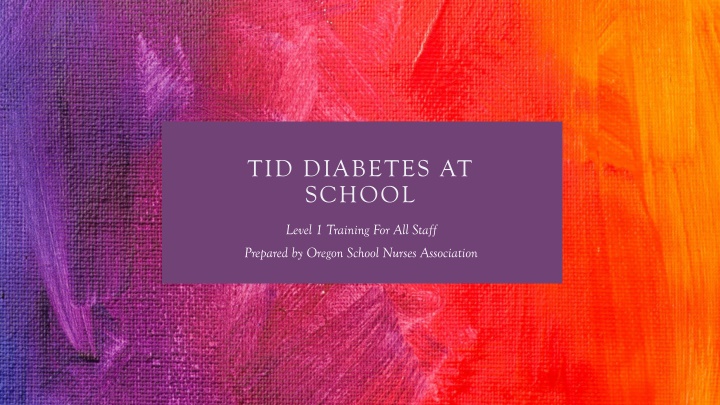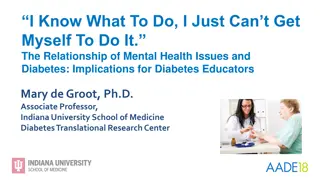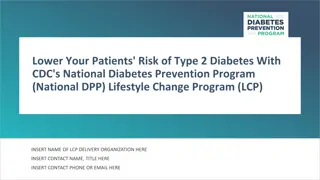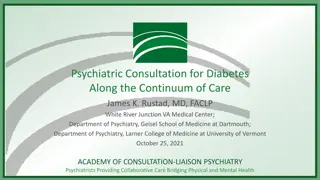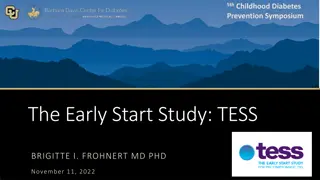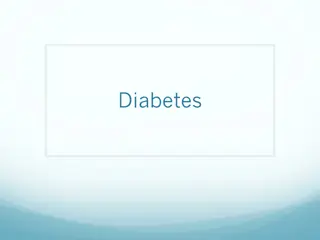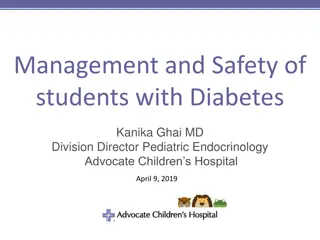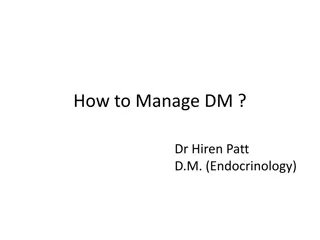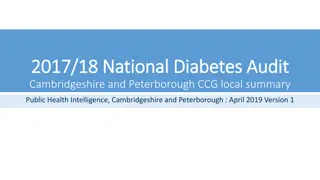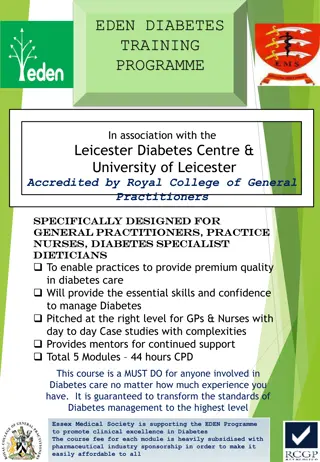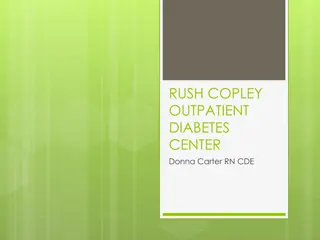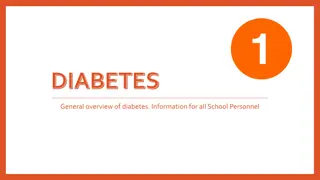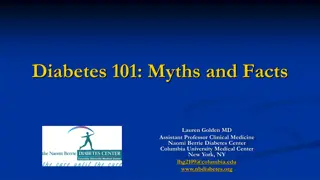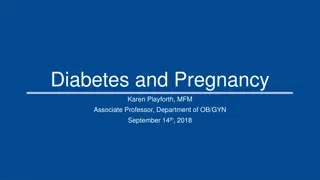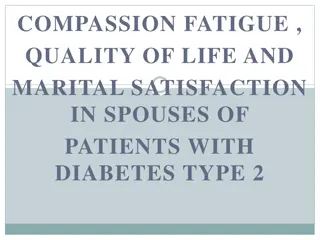T1D Diabetes at School Training
This Level 1 training prepared by the Oregon School Nurses Association aims to provide essential information on Type 1 Diabetes for all staff working in a school setting, focusing on improving health outcomes for students with T1D. The training covers basic diabetes physiology, differentiation between T1D and T2D, routine management at school, potential emergencies, and recognition of hypoglycemia. It also provides an overview of diabetes, comparison between T1D and T2D, symptoms of diabetes and the lifelong management aspects of T1D.
Download Presentation

Please find below an Image/Link to download the presentation.
The content on the website is provided AS IS for your information and personal use only. It may not be sold, licensed, or shared on other websites without obtaining consent from the author.If you encounter any issues during the download, it is possible that the publisher has removed the file from their server.
You are allowed to download the files provided on this website for personal or commercial use, subject to the condition that they are used lawfully. All files are the property of their respective owners.
The content on the website is provided AS IS for your information and personal use only. It may not be sold, licensed, or shared on other websites without obtaining consent from the author.
E N D
Presentation Transcript
TID DIABETES AT SCHOOL Level 1 Training For All Staff Prepared by Oregon School Nurses Association
DISCLAIMER Oregon School Nurses Association's educational material and/or language are intended as examples that may serve as a tool for those responsible for drafting and carrying out educational content that meet the needs of a local school or district. These examples are not authoritarian, nor should they be viewed as complying with any requirements specific or unique to any school or district or state laws. Educational resources and language should not substitute or replace the advice of legal counsel and/or research on applicable federal or local laws, regulations or ordinances.
To provide all staff general information on T1D in the school setting To create a culture of information and safety for students with T1D PURPOSE To improve health outcomes for students with T1D To serve as a prerequisite for staff who will be emergency caregivers and delegated caregivers.
DIABETES OVERVIEW Level 1 Training
LEVEL ONE OBJECTIVES 1 2 3 4 5 Understand the basic physiology of Diabetes Differentiate between T1D and T2D Identify routine management that occurs at school Understand the potential emergencies associated with T1D Recognize hypoglycemia
T1D VS T2D T1D T2D Previously referred to as juvenile diabetes Previously referred to as Adult-Onset Diabetes More common in children More common in adults Can be diagnosed at any age Can be diagnosed at any age. Autoimmune disease Insulin resistance Pancreas STOPS producing insulin Major risk factors include obesity and sedentary lifestyle.
T1D Lifelong disease/No Cure No insulin production Insulin is required to sustain life Not lifestyle or metabolic related Autoimmune Balance of carbohydrates and insulin
SYMPTOMS OF DIABETES Extreme thirst Increased hunger Frequent urination Weight Loss Fatigue
INSULIN Insulin is a hormone Insulin is released by the pancreas to control glucose in your bloodstream. Insulin helps store glucose in your liver, fat, and muscles. Insulin regulates your body s metabolism of macronutrients Without proper insulin function, your body can t store glucose Without Insulin, your body can t store fat Lack of insulin is potentially fatal
EXTRINSIC INSULIN Insulin is taken as a medication when the body no longer produces it Insulin must be administered multiple times a day by injections or may be administered by a jet injector or pump
A simple sugar that provides energy in living organisms A component of many carbohydrates GLUCOSE Sources of glucose may include fruit, sugar, rice, pasta, bread, potatoes
BLOOD GLUCOSE Blood glucose (blood sugar) is the measurement of glucose in the blood Insulin and activity lower blood glucose Carbohydrates, illness and stress raise blood glucose A blood glucose level is not good or bad it is information that guides treatment decisions Changes in blood glucose may impact emotions, mood, ability to concentrate
This occurs by either a finger stick with a capillary blood glucose (CBG) monitor or glucometer or with a device called a continuous glucose monitor (CGM). Students must check blood sugar often CHECKING BLOOD GLUCOSE Students with CGM s will have devices, such as cell phones that transmit blood glucose information Students who are not independent will require trained staff to assist in monitoring.
Everyone has high blood sugar from time to time This means blood sugar is higher than the target range HYPERGLYCEMIA AT SCHOOL This may require intervention from trained staff or changes in activity levels
CONTRIBUTORS TO HYPERGLYCEMIA Not taking enough insulin Eating extra food without taking extra insulin Getting less activity than normal Stress Illness Excitement
Frequent urination Increased thirst Blurred vision Headache EARLY SIGNS OF HYPERGLYCEMIA Fatigue Warm skin Stomachache Mood changes
SUSTAINED HYPERGLYCEMIA Fruity smelling breath Nausea and Vomiting Dry Mouth Weakness Confusion Abdominal Pain Rapid shallow breathing Coma Ketones
DIABETIC KETOACIDOSIS Hyperglycemia Blood glucose that remains untreated or high over days Sustained hyperglycemia can lead to a complications DKA called diabetic ketoacidosis (DKA):
Hyperglycemia is not always identifiable until blood sugar is checked Specially trained UAPs should provide care to individuals with hyperglycemia. TREATING HYPERGLYCEMIA Care may include extra insulin, increased water intake, increased access to bathroom and restrictions in activity.
LOW BLOOD SUGAR (HYPOGLYCEMIA) All individuals with diabetes experience low blood sugar from time to time This means that blood sugar has dropped below the target range Causes include too much activity or too much insulin or missed meal Unlike hyperglycemia, hypoglycemia can come on suddenly and progress rapidly
RISK FACTORS AND CAUSES OF HYPOGLYCEMIA Risk Factors Causes Higher insulin requirements Insulin pen or injectable insulin regimen Poor glycemic control History of frequent hypoglycemia Multiple insulin regimens Too much insulin More exercise than typical Not enough food intake
Shakiness Dizziness Sweating Rapid heart rate Difficulty concentrating Hunger EARLY SYMPTOMS OF HYPOGLYCEMIA Confusion Irritability Anxiety Headache Weakness Pallor
Clumsiness Inability to eat or drink Muscle weakness MODERATE TO SEVERE HYPOGLYCEMIA Difficulty speaking Blurry vision Drowsiness Confusion
Seizure Change in level of consciousness SEVERE HYPOGLYCEMIA Death
TREATING MILD TO MODERATE HYPOGLYCEMIA PROVIDE FAST ACTING SUGAR DO NOT MOVE STUDENT ( WALKING CAN FURTHER DECREASE BLOOD GLUCOSE) CHECK AND MONITOR BLOOD GLUCOSE ( DESIGNATED UAPS)
Glucose Tablets Candy ( not sugar free or chocolate) FAST ACTING SUGAR Soda ( not diet) Juice Sugar Honey
TREATING SEVERE HYPOGLYCEMIA Severe Act Stay with student hypoglycemia is an emergency Immediately Place student in recovery position Call glucagon trained staff or nurse Call 911
WHAT ALL STAFF NEED TO KNOW ABOUT T1D
WHAT ALL STAFF NEED TO UNDERSTAND ABOUT T1D INSULIN ACTIVITY FOOD SCHEDULING SAFETY COMMUNICATION
Insulin must be given before meals and sometimes snacks Student s schedule will need to be accommodation to allow them to test BG and administer insulin Basal Insulin may be administered at home or through and insulin pump throughout the day. Too much insulin can lead to low blood sugar Designated UAPs supervise or monitor insulin INSULIN @SCHOOL
All Students with T1D should participate in sports and PE fully Because activity may lower blood glucose levels, more planning or care may be required Students with T1D may need to check their blood sugar or have a snack before or during activity ACTIVITY @SCHOOL Occasionally significant activity such as sprinting may raise blood glucose temporarily Students should have kits and snack nearby PE teachers and coaches should know signs of hypoglycemia to watch for
Students with T1D must have flexibility in their scheduling to allow for: Testing blood glucose as needed Administering daily insulin Treating high or low blood glucose SCHEDULING @SCHOOL Student with T1D should have free access to water and bathroom Students should not be penalized if academic schedules and testing is interrupted due to a high or low blood glucose incident
Communication is critical both in among school staff and between the school and the family Report any changes to the nurse and family Identify who designated caregiver and emergency caregivers are Know where supplies and care plans are located per your training Ensure accommodations are communicated to staff COMMUNICATION @SCHOOL Ensure staff know where fast acting glucose is located Communicate changes in routine, lunch, parties or events to families in advance Communicate to families if supplies are running low Communicate to families in advance of field trips
REFERENCES IMAGES USED WITH WRITTEN PERMISSION FROM ADAM Alkhatatbeh, M. J., Abdalqader, N. A., & Alqudah, M. A. Y. (2019). Impaired awareness of hypoglycemia in children and adolescents with type 1 diabetes mellitus in north of Jordan. BMC Endocrine Disorders, 19(107). https://doi.org/10.1186/s12902-019-0441-9 American Association of Diabetes Educators. (2019). Management of children with diabetes in the school setting. The Diabetes Educator, 45(1), 54 59. https://doi.org/10.1177/0145721718820943 Birkebaek, N., Drivvoll, A., Aakeson, K., Bjarnason, R., Johansen, A., Samuelsson, U., Skrivarhaug, T., Thorsson, A., & Svensson, J. (2017). Incidence of severe hypoglycemia in children with type 1 diabetes in the Nordic countries in the period 2008 2012: Association with hemoglobin A1C and treatment modality. BMJ Open Diabetes Research & Care, 5(1), Article e000377. https://doi.org/10.1136/bmjdrc-2016-000377 BMJ Best Practice (2020) Diabetic ketoacidosis. Retrieved from https://bestpractice.bmj.com/topics/en-gb/3000097
REFERENCES Canadian Pediatric Society. (2021) Diabetes at School Retrieved from https://www.diabetesatschool.ca/tools/video-series Deeb, A., Yousef, H., Al Qahtani, N., Artan, I., Suliman, S., Tomy, M., Abdulrahman, L., Al Suwaidi, H., Attia, S., & Nagelkerke, N. (2019). Novel ambulatory glucose-sensing technology improves hypoglycemia detection and patient monitoring adherence in children and adolescents with type 1 diabetes. Journal of Diabetes & Metabolic Disorders, 18(1), 1 6. https://doi.org/10.1007/s40200-018-0351-9 Mayo Clinic (2021) Type 1 diabetes. Retrieved from https://www.mayoclinic.org/diseases-conditions/type- 1-diabetes/symptoms-causes/syc-20353011 Mayo Clinic (2021) Type 2 diabetes. Retrieved from https://www.mayoclinic.org/diseases-conditions/type- 2-diabetes/symptoms-causes/syc-20351193
